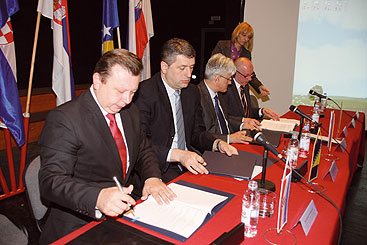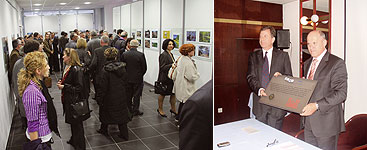Steering to match compatible goals

Steering to match compatible goals
The Sava Commission is balancing the individual needs of four countries under the framework of strong transboundary cooperation, ensuring that all Sava countries are sailing in the right direction.

By signing the Protocol on flood protection to the FASRB, representatives of the Parties to the FASRB committed themselves to regulate the issues of sustainable flood protection in the Sava River Basin with the aim of preventing or limiting flood hazards, reducing flood risk and reducing or mitigating the detrimental consequences of floods.
The Sava has the largest discharge of water to the Danube of any tributary and is the second largest by catchment area. The joint management of the Sava River Basin by Slovenia, Croatia, Bosnia and Herzegovina and Serbia is an importantmodel for the implementation of the EUWater Framework Directive for the Danube and Europe.
The Sava Commission was established in 2005 to fulfil the Framework Agreement on the Sava River Basin (FASRB). Recent efforts, such as those regarding the continuation of activities on rehabilitation and development of the Sava River Waterway, development of nautical tourism in the Sava River Basin, engagement under the Danube Strategy process, among others, have proved that the Sava Commission is a model for progress in the region.
Milestones for navigation. The Sava Commission has recently taken several significant steps for inland navigation, including the rules for transport of dangerous goods in the Sava River Basin, rules for definition of winter ports and winter shelters in the Sava River Basin, and amendments of the navigation rules on the Sava River Basin.
Results of the Project ‘Detailed Design and Prototype Installation for the River Information Services (RIS) on the Sava River’ have been officially presented to the wider public, along with the next steps in Sava RIS implementation. The application of RIS significantly contributes to navigation safety and increases the efficiency of inland transport.
In addition, the project ‘Atlas of Nautical Tourism on the Sava River’, launched recently, will promote nautical tourism on the Sava River, attract new investors and encourage tourism development in the Sava River Basin.
Improving cooperation. To further enhance cooperation in the field of water management, the Sava Commission organised the meeting ‘Fostering the FASRB implementation in the fields of water management and environment’. The meeting was held in Belgrade in May and attended by high officials of the Parties to the FASRB responsible for water management and environmental issues. The attending representatives of the parties to the FASRB have committed to take over the liabilities of their countries to realise projects of common interest, especially with regard to development of the Sava River Basin Management Plan and implementation of the project ‘Technical assistance in the preparation and implementation of the Sava RBM Plan’, establishment and implementation of the Sava GIS, development of the Hydrological Study for the Sava River Basin, etc.
The Sava Commission was especially honoured to grant the permanent observer status to the Republic of Macedonia, which is the first country to hold observer status in the Sava Commission.

Left: The photo
exhibition‚ Sava River
– Nature, People and
Cultures’ opened on Sava
Day in Gradiška, Bosnia
and Herzegovina.
Right: US Ambassador to Croatia
James Foley presented
a plaque to the Sava
Commission Chairman,
Branko Bačić, to mark the
successful cooperation of
the two institutions.
Celebrating the Sava. Sava Day, held on 1 June, promotes the exceptional ecological values and socioeconomic potentials of the Sava River for all riparian countries, and this year’s celebration, held in Gradiška, Bosnia and Herzegovina, included the signing of the Protocol on flood protection to the FASRB, as well as an exhibition of student work developed under the creative educational workshops ‘Sava River and its Friends’ organised for pupils of elementary schools in Gradiška.
In addition, prizes were awarded to the top three photographers in the ‘Sava River – Nature, People and Cultures’ photo contest for the Sava River Basin countries. “I’ve been pleased to participate in such a contest, which yielded very vivid photos presenting the diversity of nature and cultures in the region,” said First Prize Winner Danijel Kovačević, “and I am proud that few of my photos have been selected for this exhibition.”
Mapping progress in flood risk management. The workshop Sava River FloodMapping, co-organised by the Sava Commission and US Army Corps of Engineers, resulted in a detailed, digital floodplain map of the Sava River Basin. The results of the workshop will have a positive impact on the international effort under the auspices of the Sava Commission to develop flood risk maps, flood forecasting, and flood warning systems. “The work and cooperation that has been manifested here serves as a reminder to all in the region of how much can be achieved through joint efforts and shared values,” said US Ambassador to Croatia, James B. Foley.
Working toward the Danube Strategy. The Sava Commission has actively participated in the process of development of the EU Strategy for the Danube Region, focusing on raising awareness of the similarities of the main objectives of the EU Danube Strategy and the FASRB presenting the approach to sustainable development of the Sava Region and advocating in favour of potential effectiveness of the sub-regional level from the viewpoint of the Strategy implementation.
The Draft Action Plan of the EU Danube Strategy has recognised the Sava Commission as an important body in the Danube region, and several of its priority projects have been listed in the Draft Action Plan as ‘examples of projects’. “The Sava Commission strongly believes that the implementation of the FASRB-related projects in the framework of the EU Danube Strategy can yield double benefits – it can contribute to an effective implementation, not only of the FASRB, but also of the EU Danube Strategy itself,” says Mr Dejan Komatina, the Sava Commission Secretary.





